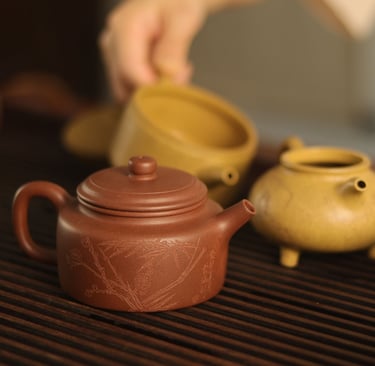How the Tea Culture Industry Can Achieve Sustainable Development
Exploring sustainable growth in the tea culture industry by focusing on reduction, reuse, recycling, rethinking, and restoration principles to ensure environmental and cultural harmony.
GLOBAL TEA CULTURE
Sustainability – it’s everywhere these days, right? But let’s get real: how many industries are actually pulling it off? Not just talking about it, but doing it. Tea, yes, tea, might not be the first thing that comes to mind when you think of sustainability. But believe me, the tea culture industry is stepping up, and it’s been making some serious moves since the 1992 United Nations Conference on Environment and Development. Ever since then, sustainable progression has become the new normal across the globe, and the tea industry is no exception.
But here’s the big question: how do we create real, lasting change in the tea industry? It’s not just about switching to eco-friendly packaging and calling it a day. It’s about rethinking everything, from production to distribution, making sure every step is as sustainable as it can be. Let’s dive into some key principles that can guide us.
The Path to Sustainable Development in the Tea Industry
Reduction: The Power of Less
First up: reduce. It’s all about efficiency. How can we do more with less? In the tea industry, this translates to cutting down on the use of land, water, and energy. In places like Fujian, where they make Narcissus tea, traditional wood fuel is being replaced by energy-efficient, low-carbon equipment. This move saves around 49,000 kilograms of firewood each year. And you know what? It’s not just about saving the environment – this shift also improves the tea quality. It's a win-win.
Let’s not forget about packaging. Bamboo and paper packaging are taking the place of plastics. It’s simple, effective, and eco-friendly. Small changes, but they add up.
Reuse: Giving Products a Second Life
Reuse is a big one. Instead of throwing things away, why not find new uses for them? In the tea industry, this could mean reprocessing tea leaves. You’ve got by-products from tea that are full of nutrients – instead of tossing them out, they can help grow more plants. Imagine a system where every tea leaf gets reused in some way.
Take Yixing teapots, for example. These iconic Chinese teapots aren’t just about making tea – they also represent the concept of reuse. Many Yixing teapots are passed down through generations, often being repaired and re-used over time rather than being discarded. This longevity is a perfect example of how products can be designed for a second life, reducing waste and giving them lasting value.
Recycling: Giving Waste New Life
Now, recycling. It’s not just about sorting your trash; it’s about repurposing things that would normally go to waste. In Dehua County, businesses have been recycling broken ceramics into porcelain powder. Since 2011, more than 1,000 ceramic enterprises have jumped on this bandwagon, reducing waste and cutting costs.
Similarly, in Japan, low-quality tea leaves aren’t thrown away. They’re turned into things like insoles and facial tissues. Waste not, want not – that’s the motto. Innovations in recycling are paving the way for a greener, more sustainable tea industry.
Rethinking: Constantly Improving
Now, let’s talk about reassessing, or as I like to call it: constantly tweaking and improving. This is where science and production come together. You can’t just set up your tea production line and forget about it. You have to keep improving. There’s no one-size-fits-all solution; it’s a continual process.
This principle is especially crucial as tea and health become more interconnected. Tea brands need to focus on quality control, make their packaging more eco-friendly, and rethink how they market their products. Think outside the box – make sustainability a core part of your brand.
Restoration: Reviving Ecosystems
The final principle is restoration. This is about giving back. In the tea industry, it means improving tea gardens, planting better varieties of tea plants, and enhancing production methods. In China, tea culture is a huge part of the national identity, and keeping that alive requires innovation and a commitment to sustainability.
Restoring ecosystems isn’t just about planting trees. It’s about ensuring the entire supply chain is working towards regenerating resources, not just using them up.
Conclusion
The key takeaway here? Sustainable progression in the tea industry isn’t just a buzzword – it’s a necessity. By embracing the principles of reduction, reuse, recycling, reassessing, and restoration, we’re looking at a future where the tea industry not only thrives but does so in a way that respects the environment.
If you’re keen to dive deeper into the world of tea and discover more about how sustainability plays a part, make sure to check out our blog. Sustainability isn’t just a trend – it’s the future of the tea industry. And it starts right now.
FAQs:
What is sustainable development in the tea industry? Sustainable development in the tea industry focuses on reducing environmental impact and enhancing the efficiency of resources like land, water, and energy. It involves principles such as reducing waste, reusing products, and improving processes to make tea production more eco-friendly.
How does recycling help the tea industry? Recycling in the tea industry helps by turning waste materials, like broken ceramics or low-quality tea leaves, into usable products. This reduces waste and minimizes costs, creating a more sustainable and efficient industry.
Can tea brands really make a difference with sustainable practices? Yes! Small changes, like using eco-friendly packaging, improving production methods, and focusing on quality control, can have a big impact. Sustainability is becoming a major factor in consumer choices, so brands that adopt these practices can lead the way in the industry.
What role does research play in sustainability for the tea industry? Scientific research helps improve tea production methods, ensuring that they are more efficient and environmentally friendly. It also leads to innovations that can help businesses stay ahead of the curve and meet sustainability goals.




